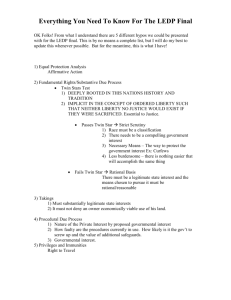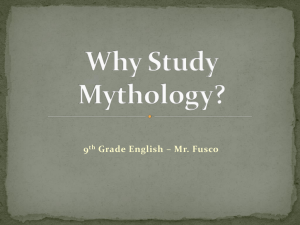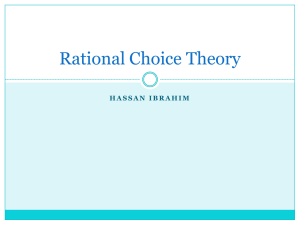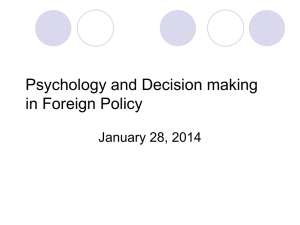Bild 1
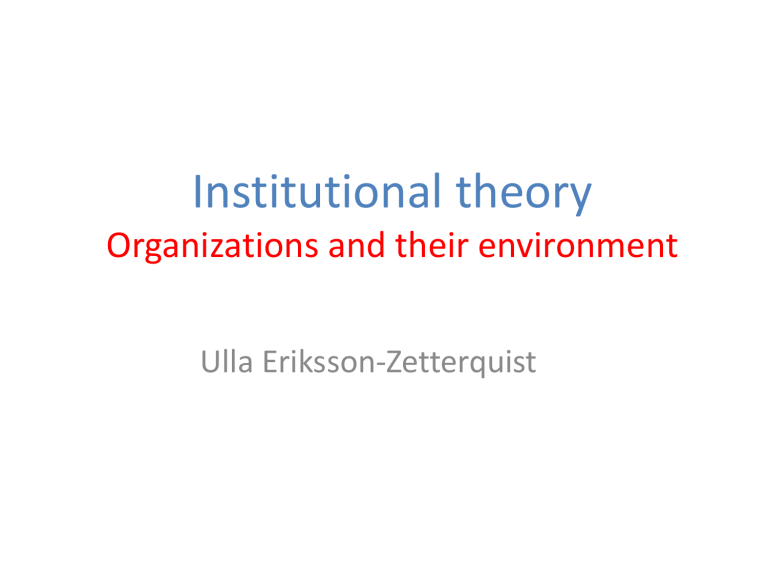
Institutional theory
Organizations and their environment
Ulla Eriksson-Zetterquist
Institutional theory
• Are organizations rational tools for achieving clear cut purposes?
• Why are organizations so similar (at least structurally?)
• Why is it so hard to change organizations?
Institutional theory - foundations
• Origin: end of 19th century in economics, sociology, political science
• Central: institutions are created when we construct our social reality
• TODAY:
• Three streams:
– Early institutional theory
– (New/neo) institutional theory
– Scandinavian institutional theory
Institutional theory: basic assumptions
• Organizations and their members are NOT rational actors but are effected by their environment and how things have been done before ( ’this is the way we have always done things ’)
• The myth about rationality is still very prevalent, and it is important to appear as rational.
4
Institutions
• Institutions are a pattern for collective action
• Creates order, stability and predictability
• Newcomers are taught ’how things have always been done here’
• Opposite to ’habit’ (local, often individual)
• Institutions are long lasting, and have a normative explanation
5
Examples of institutions
• Collective patterns of actions that have been called ‘institutions” (examples):
– Marriage, sexism, the contract, wage labour, the handshake, insurance, the formal organization, the army, presidency, the vacation, the corporation, voting.
• Jeppson, 1991: 144
» Some organizations, some cultural, some more structural
» Variously “production systems, enabling structures, social programs, performance scripts
» Each connotes stable designs for chronically repeated acticity sequences
Pursuing the metaphors
• Institution: represents a social order or pattern that has attained a certain state or property
• Institutionalization: denotes the process of such attainment
• order/pattern: standardized interaction sequences
– An institution is then a social pattern that reveals a particular reproduction process
– Followed by rewards and sanctions
Institutions…
• Limits on how individuals and organizations can act, at the same time as they enable acting
• Create and monitor rules of the game
• Make organizations and individuals adapt to its ’institutional surrounding’ (and thus can make things that seem irrational)
8
Contemporary definition
• ..more-or-less taken-for- granted repetitive social
behaviour that is underpinned by normative systems and cognitive understandings that give meaning to social exchange and thus enable self-
reproducing social order.
(Greenwood et al., 2008: 4-
5, italics in original)
We being bearer of institutions
• The beliefs, norms, rules, and understandings are not just ”out” there but additionally ”in here”. Participants, clients, constituents all
participate in and are carriers of the culture.
Thus, institutional environments are notoriously invasive. To paraphrase Pogo, We have met the environment and it is us! (Scott,
1983:16)
Three modern uses of institution
• Sociology :
– Organized and established ways of action. These actions are what are seen as the rules for a community.
• Political science:
– Describes large or particularly important collectives and associations, often public or state owned.
• Anthropology:
– As cultural, often historical effects of social order.
Early institutional theory within organizational studies
• Selznick, 1949, and others
• “Officials [in organizations] orient their actions around rules even to the point where primary concern with conformity to the rules interferes with the achievement of the purposes of the organization” (Merton 1936:199)
• Institutionalization: “organizations are infused with value beyond the technical requirements at hand”
(Selznick, 1957:17)
Early institutional theory withing organization studies
• People will defend the values and the organization, (even though it may be
“dysfunctional” according to some set of criteria)
• Organizations with more precisely defined goals and easily defined criteria for evaluation are less subject to institutionalization than those with diffuse goals and disputed evaluation criteria
Berger and Luckmann, 1966
• How an institution is maintained
– Product of human action, not always consious
– Response to our need of predictability and structure in every day life
• Saves energy
Makes it possible for us to spend time and energy to do extraordinary things
Reflektion
Creation of innovations
• We choose the easiest
(taken for granted, most accesible) way to do things and avoid chaos and disorder
Institutions thus provide us
Order
Stability
Predictibility
Flexibility
Ability to adjust
Why are organizations so similar?
• (New/neo) institutional theory
– Focus
• Organizational structure
• Processes within organizational fields
• New and early institutional theory
– Organization and environment effect each other: cultural aspects must be studied to understand how organizations develop
– Organizing in practice is not the same as the formal image of an organization
New institutional theory : Why are labour markets, schools, national states and corporations so similar when it comes to structure?
• Why don’t they seem to be individual (profit) maximizing actors?
• What makes their practices so resilient?
• How do they (the practices) become takenfor-granted?
Formal structure as myth and ceremony (Meyer & Rowan 1977)
• Formal structure (organizational chart, work planes, policies) is not what really is done in an organization
• I.e. That coordination happens, rules and procedures are followed and activities are aligned with formal structure does not have to be the case!
• Talk ≠ decision ≠ action (Brunsson)
Rather
• Plans are loosely coupled/de-coupled to activities
• Rules are broken and neglected
• Decisions have unexpected consequences
• Techniques are not always efficient and effective
The reason?
• The norm of rationality is an institutionalized myth. However:
– We believe that it exists and that it works
– We support this with arguments in order to understand and explain it.
Example
• Vocabularies of structure which are isomorphic with institutional rules provide prudent, rational, and legitimate accounts. Organizations described in legitimated vocabularies are assumed to be oriented to collectively defined, and often collectively mandated, ends. The myths of personnel services, for example, not only account for the rationality of employment practices but also indicate that personnel services are valuable to an organization.
Employees, applicants, managers, trustees, and governmental agencies are predisposed to trust the hiring practices of organizations that follow legitimate procedures
– such as equal opportunity programs, or personality testing – and they are more willing to participate in or to fund such organizations. (Meyer and Rowan, 1977:349-350)
Myths (institutionalized)
• Myths about:
– Accounting, corporate social resonsibility, personnel recruitment, safety regulations,
• Are assumed to be efficient
• Show the organization as rational, modern, working with appropriate methods, responsible
• Myths are spread and there is pressure on organizations to adopt them
• Makes organizations: rational, legitimate, stable, gives access to resources -> survival
Myths
• Make organizations look alike
• A problem must be solved in legitimate ways:
– E.g. quality problems must be solved with ISO
9000, not new ways of organizing.
Organizational fields
• The environment is created by and creates in turn organizations
• Organizations have to adapt to the structure in their organizational field.
• Organizational field:
– Organizations that exchange raw material, goods, knowledge, professional values etc
– Concept is kind of like industry but wider, including suppliers, customer groups, legitslators, pressure groups etc.
The consequence of belonging to a field: becoming similar through isomorphism
(DiMaggio & Powell, 1983)
• Coercive pressure • Normative
– Political pressure
– Legislation, adaption to new technology
• Mimetic pressure
– Uncertainty (from unclear objectives, overload of information)
– Imitate a more successful org in the field
– Comes from professionalization
– By hiring professionals one get people with similar education -
>homogenization
– Professional networks -> enhance homogenization
Why then isomorphism?
• Make organizations
– successful
– survive
– Develop a common language
– Provides legitimate stories – it is known what a
”technician” or ”accountant” do
• Organizations do change, not due to what the organization need, but through restraints, regulations, organizing among the members within the field.
Loose coupling
• The formal structure is loosely coupled from what really happes in the org:
-> two organizational structures:
– Formal: changes when laws, norms and fashions change.
– Informal: coordinates what people do in an organization
Loose coupling: function
• To follow institutionalised myths give legitimacy
• Legitimacy assures resources (financial, media support, customer support, employees)
• Makes it possible for the org to seemingly live up to different (often incompatible) demands from all sorts of interested parties (eg both sustainability and profitability)
• Gives the org leeway to act
Why is it so difficult to change organizations?
• Scandinavian institutionalism: both change and stability is the norm for organizing
• Focus on processes (rather than field)
– How are identities formed?
– How are rules established and broken?
• How does deinstitutionalization happen?
Change through reforms
• Reforms are (a better) solution to problems in organizations
– Can be something that has been done earlier but are ”repackaged” and seems new
– Reforms are often forgotten after a while
• Personnel turnover, change of management, change of mgmt consultant, new reforms
• Change focuses the weak spots in the org -> not good for morale, productivity or innovativeness
Ideas, fashions, and management recipes that travel
•
How do ideas travel?
•
Why do ideas travel?
•
What ideas travel?
31
How do management ideas travel?
Diffusion theory
•
There must be an energy source (managament, consultant)
•
In the ideal world ideas travel without resistance
(no friction)
•
Ideas will not change during their journey
32
How do management ideas travel?
Translation theory
•
It is difficult or impossible to find ’the original source’
•
Friction and resistance give life and energy to an idea
•
Ideas change when they travel, but that might mean that they get better
•
Translation is an active and collective process that creates, not just reproduce
33
Why do management ideas travel
?
•
There are sellers of ideas (universities, consultancy firms)
•
They are seen as good and rational
(institutionalized myths)
•
Uncertainty: professionals mimic each other, professionals travel from org to org
34
Ideas come and go, like fashion
•
Fashion= a collective selection mechanism
•
Fashion allows conformity AND individuality
•
Fashion reproduces
AND changes an old order
35
Deinstitutionalization
• Ideas and trends loose status
– E.g Swedish municipalities with ’målstyrning’
(management by objectives)
– Fashions become too popular
– Organizations want to be unique
• Start looking for new trends
Summary:
What is the point of institutions?
• Institutions are made by us at the same time as they make us (”we invent culture so that culture can invent us”)
• Effect how people within and outside the institution act and can act, sets rules of the game.
• Defines the criteria for success and failure
Summary institutional theory
• Institutional theory
– Many different approaches
– Focus: why organizations are not rational actors and how stability is achieved
• Scandinavian institutionalism
– Focus on the process instead of the results
– Both stability and change is the usual state of affairs!
– Fashions and trends are effecting organizing

